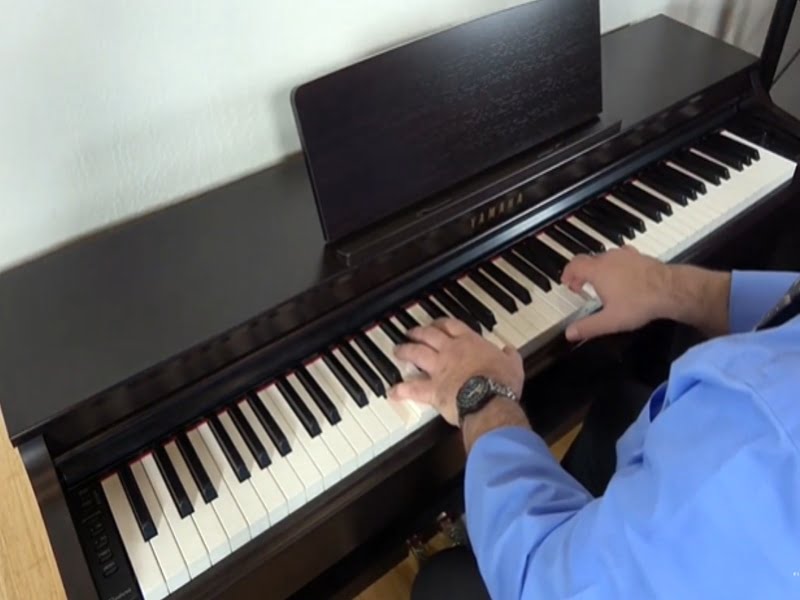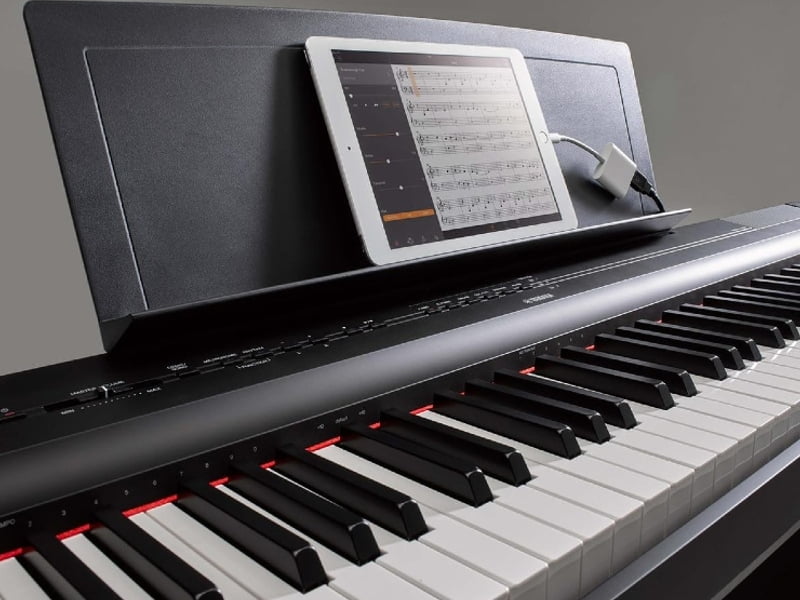The Clavinova, Yamaha’s cream of the crop, is a highly-regarded instrument. In the Yamaha P125 vs CLP 625 bout, can an entry-level digital piano stand a chance?
Yamaha has been in the business of making high quality pianos for over a hundred years. It is no wonder that, when the company went into the realm of electronic instruments in the late 1950s, they became an instant hit.
A few decades later, in 1983, the company launched the Clavinova. And this, many will agree, is the prototype of the modern digital piano. In the following years, they have come up with hundreds of models under over a dozen lines including the MODUS, ARIUS, and Piaggero, just to name a few.
Our two main subjects for today – the Yamaha P125 vs CLP 625 – are under the P or Portable Series and the Clavinova, respectively. The former is marketed as an entry-level instrument for beginners, ergo cheaper. The latter, on the other hand, has a steep price tag because it is a Clavinova. But because it is the series’ introductory piece, it seems slightly lacking. On top of that, the P125 has features that the CLP 625 does not have.
The question now is, would spending almost $3000 on a Clavinova be a smart decision or would the economical P-series model be a better buy?
Yamaha P125 vs CLP 625: Comparison Chart




Last update on 2025-07-02 / Affiliate links / Images from Amazon Product Advertising API
Yamaha P125 vs CLP 625: Head-to-Head Comparison
As aforementioned, the P125 is a mid-range digital piano in the entry-level P series while the CLP 625 is a basic Clavinova, the elite line of Yamaha. These two are completely different; from the actual keytops to everything else underneath it.
It’s easy to conclude that the Clavinova, albeit one of its most basic models, will win in the Yamaha P125 vs CLP 625 showdown. But the P-series piece, as noted above, has some good tricks up its sleeve.
For instance, the P125 has all the important playing modes while the CLP 625 lacks one. This Clavinova surprisingly has very few voices. And I find this truly odd, the latter has no auxiliary lines for amplification. I’m not exactly sure why but I’d hazard a guess that it’s because the CLP 625 was launched in 2017, a year earlier than the P125.
Despite all those flaws, the CLP 625 does win here over its ‘lesser’ sibling, but only by just a little bit. Find out all the specifics detailed below.
Feel and Playability
The Winner: Yamaha CLP 625

Yamaha, being in the industry for over a hundred years, has almost perfected the feel of their digital pianos. It’s quite close to the real acoustic thing, in fact. However, the company doesn’t always outfit their pieces with the best though, probably to cut on costs. In this particular aspect, the CLP 625 has all the stellar parts compared to the P125, making the former the winner.
+Hammer Action
The P125 is equipped with Yamaha’s Graded Hammer System – the company’s most fundamental digital piano hammer mechanism. To be fair, this isn’t a bad set-up – it’s fully weighted and aptly graded. But the CLP 625’s GHX3 has a bit more weight, has better delay, and even has escapement.
+Touch Sensitivity
This function adds so much realism to digital pianos because it allows expression to come out in one’s playing. Both our featured models have four levels of touch sensitivity: Fixed, Soft, Medium, and Hard.
+Key Texture
I love the fact that the CLP 625 has synthetic ivory and ebony keytops, that’s why it wins here too. But it’s really quite unfortunate that the company couldn’t furnish the P125 with something better than just white plastic keys.
Tone
The Winner: Tie
I expected to be completely wowed by the CLP 625 in this aspect. And while that is the case, the Clavinova did not surpass the P-series piece by a whole lot, that’s why they tied here, in my personal estimation.
+Tone Generator
The sound engine on the P125 is the Pure CF while the CLP 625 is equipped with the CFX and Bosendorfer Imperial. All these sample sources are top-notch Yamaha grands, it’s impossible to have any complaints. On top of that, the sampling method used for both is practically the same.

+Sound Library
Interestingly, the ‘lowly’ P-series piano bested the Clavinova in this regard. The former has 24 voices, four of which are grand pianos; while the latter just has 11.
The same is true with the preset demo tracks. The P125 has 21 demos and 50 pre-recorded piano pieces while the CLP 625 only has ten.
Piano Functions and Features
The Winner: Tie
It was quite difficult to come up with a ‘winner’ in this chapter because, while the CLP 625 bests the P125 in some aspects, it falls short or outright lacks certain functions in others. Continue reading on to see what I’m talking about.
+Polyphony
When choosing a digital piano, it’s best to go for a piece with at least 100-count polyphony. Most Yamahas are reliable in this regard. The P125 has 192 – a really good number for an entry-level instrument. The CLP 625, on the other hand, has a whopping 256.
+Playing Modes
There are three must-have playing modes in digital pianos: Layering (mixing two or more different voices at once), Split (halving the 88 keys into two so each side can play a different voice), and Lesson (halving the 88 keys into two so that each side can play the same voice at the same octave).
The P125 has all these playing modes but the CLP 625 only has two.
+Effects
It would surprise many that both the Clavinova and the P-series models share the same effects: Reverb (four types each), Intelligent Acoustic Control, Sound Boost, and Damper Resonance, just to name a few.
All these practical effects allow the player to simulate the experience of playing a real acoustic upright or grand in different environments, very helpful during practice sessions especially when one is preparing for a performance.

+Recording Capability
The capability to record tracks in a digital piano is quite indispensable in this day and age. While both of our featured models can capture two tracks (of up to 100KB per track), I feel like that’s not big enough. Their contemporaries from other companies can record a whole lot more.
+Connectivity
The good news is that both have pretty good connectivity systems in place so internally recorded tracks can be moved to a computer via the USB port. It’s also great that both models can be manipulated via several apps which makes the playing experience easier and more interesting.
Apart from that, these two Yamahas have hook-up for the pedal, two headphone ports, and the plug for the DC In. The P125 is equipped with an AUX Out for external amplification. The CLP 625 is not,
+Speaker System
To be honest, added amplification is a must-have for P125 because its 7W speaker system is not that impressive. The CLP 625 has a whopping 20W – amazing enough, even on its own. But it would have been better if it still had an AUX Out just so it wouldn’t get drowned out in a full band set-up.

The Similarities
There is no denying that the CLP 625 and the P125 have massive differences, especially in terms of the hammer action and the tone generation. But these two 88-key Yamahas are pretty similar in some instances, possibly because the two were developed and then launched at almost the same time.
And to be honest, those common denominators are the reasons why the so-called entry-level model matches up with the basic Clavinova.
It’s fair to conclude that in the Yamaha P125 vs CLP 625 face off, the former still has an edge. But because of the huge price disparity, it’s understandable why many still prefer the P-series piece over the Clavinova.
Quick Rundown of the Yamaha CLP 625
Quick Rundown of the Yamaha P125
- A fully weighted digital piano with 88 full-sized piano-style keys
- GHS weighted action is heavier in the low keys and lighter in the high keys, just like an acoustic piano
- The pure CF sound engine faithfully reproduces the tone of the acclaimed Yamaha 9' CFIIIS Concert Grand piano
- Split Mode lets you play a different voice with each hand
- USB to host connectivity with MIDI and audio transfer means you only need one Cable to connect to your music-making software
Last update on 2025-07-02 / Affiliate links / Images from Amazon Product Advertising API
Product Videos
Related Articles to Yamaha P125
- Yamaha P150 vs P125: The Battle of the P-Series Models
- Yamaha P125 vs Roland FP 60: Which is the Better Investment?
- Yamaha P-121 vs P-125: Finding the Best Portable Yamaha Piano
- Yamaha P125 vs Korg LP 380: Which Piano Is Better for Your Needs?
- Yamaha P125 vs P85: Can the Outdated Digital Piano Beat the Newer One?
- Yamaha P125 vs DGX 670: Which Piano Comes Out on Top?
- Yamaha P125 vs Korg SP 280: Which is the Better Beginner’s Digital Piano?
- Yamaha P-255 vs P-125: Finding the Better Option for Beginners
- Yamaha P125 vs YDP S34 Comparison: Does the Portable P125 Hold Up Against a Console Digital Piano?
- Yamaha P125 Vs YDP 164: Should You Get A Console Or Digital Piano?
- Yamaha YDP 103 Vs P125: Should You Get a Portable or Console Digital Piano?
- Yamaha P125 Vs Kawai ES110 Comparison: Which Is The Best Portable Digital Piano
- Yamaha P125 vs Casio PX S1000: Which Digital Piano Is Worth Your Money?
- Casio PX-870 Vs Yamaha P-125: Should You Get A Portable Or Console Digital Piano?
- Alesis Recital Vs Yamaha P125: Which Is The Right Pick For You?
- Yamaha P45 VS P115: Which P-Series Newbie Gives You More Value for Money?
- Alesis Recital Pro vs Yamaha P125 Comparison: Which Is The Best Portable Digital Piano?
- Alesis Prestige Artist vs Yamaha P125 Comparison: Why the Yamaha P125 Is the Better Investment
- Yamaha P125 vs Casio PX-770 Review: Why the Yamaha P125 Beats Out the Casio Console Digital Piano
- Yamaha P125 vs DGX 660 Comparison: Can the P125 Hold Its Own Against the DGX 660?
- Yamaha P125 vs Roland FP-30X Review: Why the Roland FP-30X Comes Out On Top
- Yamaha P125 vs P515 Review: Why the Yamaha P515 Is the Better Investment
- Yamaha P115 vs P125 Review: Can the P125 Beat Out Its Predecessor?
- Yamaha P125 vs Roland FP30: A Close Battle Between Two Great Digital Pianos
- Yamaha P45 vs P125: Why the Yamaha P125 Is the Better Pick for Pianists
- Yamaha P71 vs P125: Why the Yamaha P125 Is the Better Investment
References:
- Yamaha CLP 625: https://usa.yamaha.com/products/musical_instruments/pianos/clavinova/clp-625/specs.html#product-tabs
- Yamaha P125: https://usa.yamaha.com/products/musical_instruments/pianos/p_series/p-125/specs.html#product-tabs
Lulacruza is an electronic folk duo operating at the junction of the hypermodern and the ancient. Our music weaves together hypnotic female singing, South American folk instruments and electronic processing, while channeling pulsating waves from the source of creation.
Lalucruza is also a community where you can connect with other music lovers to collaborate, exchange ideas and share knowledge. A platform for who wants to learns the basics of playing piano, guitar, drum masters’ technique, etc.. is the premise of our website.
